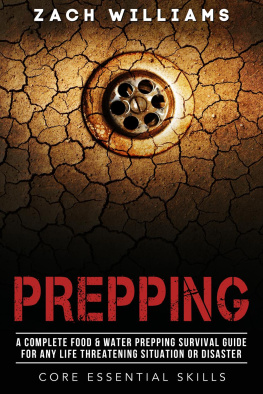Additional Resources:
https://survivalist.com/
Copyright 2017 CDI Publications, LLC. (Kindle Edition)
Print Subscriptions/ Publisher: 866.437.6570
PO Box 9 Boynton B each, FL 33435
Legal Disclaimer : The Survivalist Magazine staff and CDI Publications, Inc. have made every effort to ensure the accuracy of the information presented within these pages. Although, from time to time an error may occur, due to the serious nature of the content expressed herein, we suggest you thoroughly research and/or seek legal, professional or medical advice on any topic exposed in Survivalist before taking action.
CDI Publications, Inc. and its staff are not liable for any damages resulting from miss-use of the information contained herein or the accuracy of the information provided to us by our contributors.
Table of Contents
Introduction
You dont have to be a master criminal for the art of lock picking to come in handy. In the event of social collapse, there are no rules the person with the right tools and skill set survives. In all actuality, its not at all necessary for a burglar to master this skill, as easier ways than lock picking exist to break into your car or house. Any old rock or brick will do. But when it comes to clearing a locked door and covering your tracks in the process, this skill is not only handy, its essential. To continue using the lock youve broken into, youll want to keep it working soundly.
So, no, you dont have to be a criminal, and neither do you have to be an experienced locksmith to master the art. Instead, you can become what is commonly known as a hacker. Much like computer hackers, those who pick locks recreationally do so as a hobby. Not only is it an extremely practical skill to have, once you get the hang of it, its fun. Just keep your fun in check and dont push beyond hobby to breaking-and-entering, as to pick someone elses lock is a criminal offense, if you intend to steal anything within. However, as mentioned, if the worst of catastrophes should happen, breaking-and-entering will not be the issue your survival will be.
In this book, youll learn not only how to pick a lock, but the basic principles about locks and keys, how they work, and how easy it is to bust into nearly any lock. Knowing this may influence, in you, a whole new outlook on security. Even with a lock or four on your door, you arent completely safe. An experienced picker can break into anything using just a screwdriver and a paper clip or two. And, with the proper tools like a lock picking kit with various pick tips and a torque wrench they can break in even faster. Discovering how easy it is for even you to master lock picking may convince you that additional security measures should be taken when guarding your home and your valuables against invaders. A lock is not the be all, end all. You should always back up your backup.
This book will discuss not only techniques to picking a lock with a basic kit or with an electric pick gun, but also with your average everyday objects. A pick gun uses pieces of metal shaped like picks, which vibrate, pushing the pins up. This device might work instantly, or not at all, making it an unreliable strategy in emergency situations. A kit is the most useful, as it comes with a torque wrench and picks with different shaped heads which work in certain locks or improve technique; however, knowing how to break in using basic everyday tools, though a bit trickier, is something well cover as well.
Though not all locks are the same, the conceptualization of most locks is similar. The various shapes and sizes of locks does not mean that youll have to learn a brand new strategy for each; you may just have to adjust a bit. Look at one simple lock, and youll get the basic idea, as most work in the same way.
What most dont realize is that anyone can learn how to pick a lock. The common mechanical characteristics of a lock are what you, as a lock-picker, will be exploiting. So, in this book, we will identify these mechanical characteristics, and we will explain how to manipulate them. We will also look at exercises to practice your technique. If you want to become an advanced lock-picker, having the ability to unlock any lock in under thirty seconds isnt something youll master on your first or second try. Practice makes perfect. Not only does practice make perfect, but having the right tools will significantly improve your technique. And you dont have to invest in a huge tool box either. We will discuss how to create your own lock picking tools out of everyday materials.
In the event of catastrophe or even in the event of everyday life, this skill may come to your aid when youre in desperate need of it. Will you be ready?
Chapter 1: Under Lock & Key
[for graphics: http://www.gregmiller.net/locks/mitguide/chapter2.html ]
[ #13566531 ]
So how does a key open a lock? Thats what well address in this chapter.
The vocabulary for the basic components of a lock varies between manufacturers and between locales, so refer to the diagram below if theres any confusion between manufacturer labels and this chapters descriptions.
A Basic Cylindrical Lock (Pin Tumbler Lock)
Well use a pin tumbler lock (a cylindrical lock) to discuss the devices inner workings, and the way a key opens a lock. Later on in the chapter, well talk about how picking can manipulate these inner workings.

[not an approved image; reference for graphics department]
The cylindrical lock is often used by deadbolts and pin tumbler locks. As the cylinder (the plug) in a pin tumbler lock is turned by the key, the attached cam pulls the bolt in, opening the door. Likewise, if the cylinder or plug is turned the other way, the bolt is released by the cam, snapping a spring which locks the bolt into place. A deadbolt lock only has the cylinder to slide the bolt back and forth, not the spring, making a deadbolt more secure. A latch thats driven by a spring is easier to manipulate.
The first diagram shows the keyway of a plug. The keyway is like a puzzle for the key. The key is inserted into this keyway, which has protrusions called wards that interact with the key, restricting which key may open the lock. When the correct key is inserted, the cylindrical plug rotates, while the hull of the lock does not.
In a cylindrical lock, there is a series of paired pins, each pair of which sits in a shaft which is situated in the central plug down through to the plugs housing. The pairs are set by springs at the top of the shafts. If no key is inserted into the lock, each pairs bottom pin lies entirely inside the plug. The top pin protrudes halfway from the housing and halfway from the plug, so that the plug doesnt turn, but is secured to the housing.
The notches in a key press the pins to certain levels when the key is inserted in the lock. If you insert the wrong key, the top pins will be positioned partially in the housing and partially in the plug, so the locks plug will not turn and the door will not open.
Pin one is the first pin the key touches, followed by the second, third, fourth and fifth (depending on how many pins the lock has). Each pin is lifted by the key until the space between the driver pin and the key pin closes at the shear line. Once all the pins have reached the shear line, the plug rotates, opening the lock. The pins connection point must line up directly at this shear line, as it is the part of the lock where the housing and the cylinder connect. The pins must be on either side of the shear line the lower pins entirely in the plug and the upper pins entirely in the house or the lock will not open. If the wrong key is used, any one of the pins may not reach the shear line; instead they may protrude between the plug and the hull, preventing the rotation of the plug. With the right key, the pins are not holding the plug to the housing, so it can rotate, pulling the bolt out or pushing it in.








